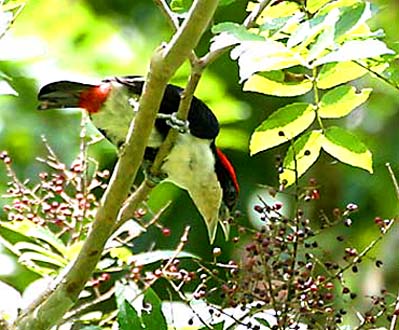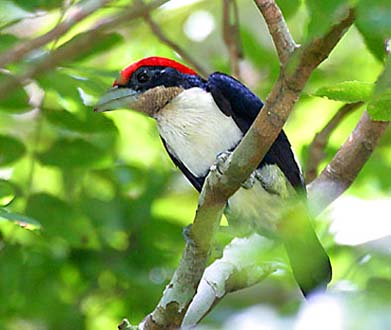| |
a web page by Don Roberson |
NEW WORLD BARBETS Capitonidae |
- 14 species in the Neotropics
- DR personal total: 10 species (71%), 2 photo'd
|
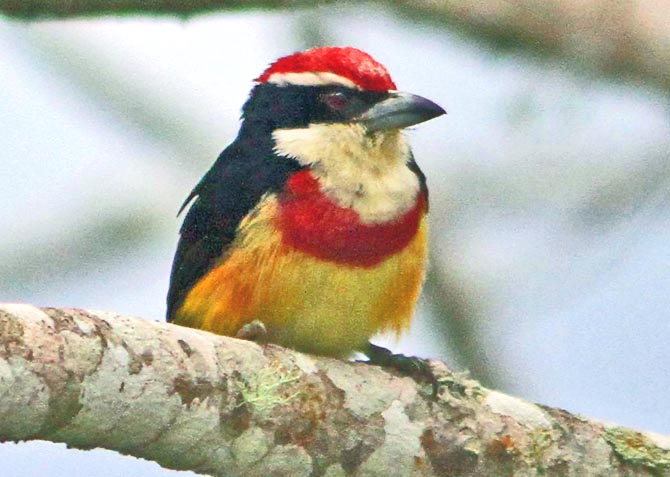 The
New World barbets are among the most gorgeous birds of South American
forests. Yet some are so local and restricted to isolated habitats that
they were first discovered to science in my lifetime. One of these is
the truly spectacular Scarlet-banded Barbet (left),
discovered in 1996 in cloud forest near the headwaters of the Rio
Cushabatay, Peru (O'Neill et al. 2000). Crisply arrayed in striking
patterns of deep scarlet, bright yellow, forest green, black and white,
it may be the most impressive barbet of them all. The
New World barbets are among the most gorgeous birds of South American
forests. Yet some are so local and restricted to isolated habitats that
they were first discovered to science in my lifetime. One of these is
the truly spectacular Scarlet-banded Barbet (left),
discovered in 1996 in cloud forest near the headwaters of the Rio
Cushabatay, Peru (O'Neill et al. 2000). Crisply arrayed in striking
patterns of deep scarlet, bright yellow, forest green, black and white,
it may be the most impressive barbet of them all.
In
2004 I wrote, in an earlier version of this page: "It is currently
known only from the cloud forest on one mountain at 1450m (4750').
There have been follow-up birding expeditions that have refound it but
not without difficulties of near-biblical proportions! I list it among
my "top 50" best birds in the world, but I strongly suspect I'll never
make it to the remote location to try for this one." Those difficulties
included a river boat trip, camping in remote rain forest, and a steep
hike. |
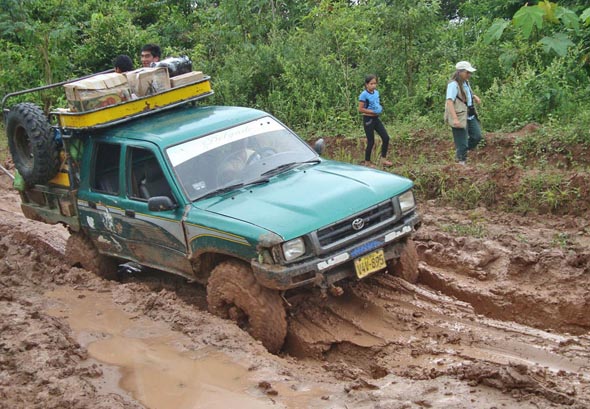 In
2010 another population of Scarlet-banded Barbet was discovered in the
Cordillera Azul, about 50 mi southwest of the original location, and
again in cloud forest 1400-1600m (~4500-5500'). But this time there was
a road that went to the site — one could drive there! Or at least
that's what I had heard. We tried this in Nov 2014. One can be driven
there by an experienced driver in a modified high-centered Toyota truck
— if one is willing to contend with 6-8 hours of a bouncing truck in
thick mud, and getting stuck multiple times. In our case, it took 11
hours from the end of pavement to reach Flor de Café in the
middle of the night (right). Our barbet was found the next day (photo
above). In
2010 another population of Scarlet-banded Barbet was discovered in the
Cordillera Azul, about 50 mi southwest of the original location, and
again in cloud forest 1400-1600m (~4500-5500'). But this time there was
a road that went to the site — one could drive there! Or at least
that's what I had heard. We tried this in Nov 2014. One can be driven
there by an experienced driver in a modified high-centered Toyota truck
— if one is willing to contend with 6-8 hours of a bouncing truck in
thick mud, and getting stuck multiple times. In our case, it took 11
hours from the end of pavement to reach Flor de Café in the
middle of the night (right). Our barbet was found the next day (photo
above).
A number of American barbets are scare or
local or little-known. When I was just getting into birding in the
1970s, an important mentor to me was then a graduate student at U.C.
Berkeley, J. Van Remsen (now at Louisiana State University). Van was
then young and enthusiastic; for a Ph.D. thesis he chose field work on
the Amazon River at Leticia, Colombia. When Van came back to the Bay
Area after his first field season (circa 1974, a time when there were
very few field guides to South America) I asked Van what was the most
spectacular bird he had encountered in the Amazon Basin rainforest that
was not pictured in any field guide. His answer, after some thought,
was the Lemon-throated Barbet. Today, of course, you can find lots of
field guide art of this species but back there was nothing. That barbet
was an astonishing package of bright yellow, deep scarlet, deep black
and rich green hopping in the canopy of the dense jungle. What a treat!
Interestingly enough, in more recent years Van Remsen and some
of his students studied the stomach contents of ten species of New
World barbets, plus toucans, trogons, and motmots (Remsen et al. 1993).
The predominant condition for most species of American barbet was that
the stomach contents were fruit only, although these barbets eat a lot
more arthropods than related species (e.g., both toucans and
toucan-barbets eat more fruit than do New World barbets). One species,
however, bucked the trend and had more vertebrate and arthropod matter
in its stomach than fruit. It was our friend the Lemon-throated Barbet.
|
|
One
of the most perfect spots in South America is Rio Cristalino Lodge. In
the heart of an almost untouched virgin rain-forest in the center of
Amazonian Brazil, this incredible lodge has it all. Everything one
could want in a Neotropical jungle is here: jaguars, tapirs, huge
curassows, a black-water stream in which you can swim, and an abundance
of birds and butterflies. Among the birds, none are more striking than
the toucans and barbets that come to fruiting trees in the forest, and
among those is Black-girdled Barbet (above). It is a
species that relies heavily on fruit, and is thus found where the trees
are fruiting. I find these two shots by Arthur Grosset evocative of my
own visit several years ago. The fruiting trees change with the
seasons, but when one is found, the joy is in watching birds or mammals
arrive to eat the small but abundant fruits. Usually the views are of
birds way up in the canopy, so these shots are particularly impressive.
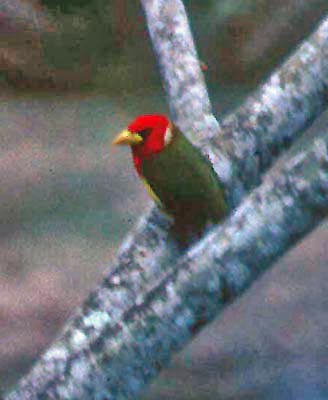
My own photographic efforts in Neotropical forests have been limited
and rather poor. I have this distant shot of a male Red-headed Barbet
(right) at its nest tree; he and his mate were excavating and enlarging
a hole in this dead tree in western Ecuador. This species is very
sexually dimorphic, and the female is much less colorful than the male.
Like other barbets in the tropics around the world the American Barbets
excavate holes in which they lay eggs. They also have zygodactyl feet
(two toes forward, two backwards) for clinging to trees (Short &
Horne 2001).
Barbets are found in tropical forests
around the globe. Molecular evidence has shown that New World barbets,
toucans, and two birds in Semnornis (e.g., the
toucan-barbets) are more closely related to each other than they are to
Old World barbets (Burton 1984, Prum 1988, Sibley and Ahlquist 1990,
Lanyon & Hall 1994, Barker & Lanyon 2000, Johansson et al.
2001, Johansson & Ericson 2003, Moyle 2004). Given the evidence
that toucans are actually 'big-billed New World barbets' when compared
to barbets in the Old World, most authorities (including the South
American checklist committee) consider the set to represent five
separate families: Asian Barbets [Megalaimidae] African Barbets
[Lybiidae], New World Barbets [Capitonidae], Toucan-Barbets
[Semnornithidae], and Toucans [Ramphastidae]. |
Photos: Photos: The Scarlet-banded Barbet Capito wallacei was photographed at Flor de Café, Peru, on 16 Nov 2014. Arthur Grosset photographed the Black-girdled Barbet Capito dayi at a fruiting tree in the canopy at Rio Cristalino Lodge, Brazil, in 2003. The Red-headed Barbet Eubucco bourcierii was at the Rio Palenque reserve, Ecuador, 4 Oct 1989.
Photos
© Arthur Grosset and Don Roberson, used with permission, all
rights reserved. Many more fine Arthur Grosset photos are on his web page.
Family Book: Rating: 
Short, L.L., and J.F.M. Horne. 2001. Toucans, Barbets, and Honeyguides. Oxford Univ. Press, Oxford.
I
confess that I don't own this book, nor have I done more that quickly
glance through it in a bookstore. Yet every one of the Oxford
University Press series on bird families has been excellent, and this
looks equally solid. I presume that the "meat" of this book has been
summarized by the same authors in their Handbook of the Birds of the World
series (Short & Horne 2002) which I do own and have studied.
Consistent with Oxford books in this series, the introductory material
is extensive and the species accounts thorough. Plates and
illustrations enliven and enhance the text. If I have any quibble, it
is with the conservative approach to family level taxonomy but, then
again, this was written before the molecular studies by Johansson et
al. (2001) and Moyle (2004).
Literature cited:
- Barker,
F.K., and S.M. Lanyon. 2000. The impact of parsimony weighting schemes
on inferred relationships among toucans and Neotropical barbets (Aves:
Piciformes). Molecular Phylogenetics and Evolution 15: 215-234.
- Burton,
P.J.K. 1984. Anatomy and evolution of the feeding apparatus in the
avian orders Coraciiformes and Piciformes. Bull. Brit. Mus. (Natural
History) 47: 331-441.
- Johansson, U.S., T.J.
Parsons, M. Irestedt, and P.G.P. Ericson. 2001. Clades within "higher
land birds," evaluated by nuclear DNA sequences. J. Zool. Syst. Evol.
Research 39: 37-51
- Lanyon, S.M., and J.G. Hall.
1994. Re-examination of barbet monophyly using mitochondrial-DNA
sequence data. Auk 111: 389-397.
- Moyle, R.G.
2004. Phylogenetics of barbets (Aves: Piciformes) based on nuclear and
mitochondrial DNA sequence data. Mol. Phylog. Evol. 30: 187-200.
- O'Neill, J.P., D.F. Lane, A. W. Kratter, A.P. Capparella, and C.F. Joo. 2000. A striking new species of barbet (Capitoninae: Capito) from the eastern Andes of Peru. Auk 117: 569-577.
- Prum,
R.O. 1988. Phylogenetic interrelationships of the barbets (Aves:
Capitonidae) and toucans (Aves: Ramphastidae) based on morphology with
comparisons to DNA-DNA hybridization. Zool. J. Linnaean Soc. 92:
313-343.
- Remsen, J.V., Jr., M.A. Hyde, and A.
Chapman. 1993. The diets of neotropical trogons, motmots, barbets and
toucans. Condor 95: 178-192.
- Short, L.L., and J.F.M. Horne. 2002. Family Capitonidae (Barbets), pp. 140-219 in Del Hoyo, J. Elliott, A., & Sargatal, J. eds. Handbook of the Birds of the World. Lynx Edicions, Barcelona.
- Sibley, C.G., and J.E. Ahlquist. 1990. Phylogeny and Classification of Birds of the World. Yale Univ. Press, New Haven, CT.
|
|
|

 The
New World barbets are among the most gorgeous birds of South American
forests. Yet some are so local and restricted to isolated habitats that
they were first discovered to science in my lifetime. One of these is
the truly spectacular Scarlet-banded Barbet (left),
discovered in 1996 in cloud forest near the headwaters of the Rio
Cushabatay, Peru (O'Neill et al. 2000). Crisply arrayed in striking
patterns of deep scarlet, bright yellow, forest green, black and white,
it may be the most impressive barbet of them all.
The
New World barbets are among the most gorgeous birds of South American
forests. Yet some are so local and restricted to isolated habitats that
they were first discovered to science in my lifetime. One of these is
the truly spectacular Scarlet-banded Barbet (left),
discovered in 1996 in cloud forest near the headwaters of the Rio
Cushabatay, Peru (O'Neill et al. 2000). Crisply arrayed in striking
patterns of deep scarlet, bright yellow, forest green, black and white,
it may be the most impressive barbet of them all.  In
2010 another population of Scarlet-banded Barbet was discovered in the
Cordillera Azul, about 50 mi southwest of the original location, and
again in cloud forest 1400-1600m (~4500-5500'). But this time there was
a road that went to the site — one could drive there! Or at least
that's what I had heard. We tried this in Nov 2014. One can be driven
there by an experienced driver in a modified high-centered Toyota truck
— if one is willing to contend with 6-8 hours of a bouncing truck in
thick mud, and getting stuck multiple times. In our case, it took 11
hours from the end of pavement to reach Flor de Café in the
middle of the night (right). Our barbet was found the next day (photo
above).
In
2010 another population of Scarlet-banded Barbet was discovered in the
Cordillera Azul, about 50 mi southwest of the original location, and
again in cloud forest 1400-1600m (~4500-5500'). But this time there was
a road that went to the site — one could drive there! Or at least
that's what I had heard. We tried this in Nov 2014. One can be driven
there by an experienced driver in a modified high-centered Toyota truck
— if one is willing to contend with 6-8 hours of a bouncing truck in
thick mud, and getting stuck multiple times. In our case, it took 11
hours from the end of pavement to reach Flor de Café in the
middle of the night (right). Our barbet was found the next day (photo
above). 